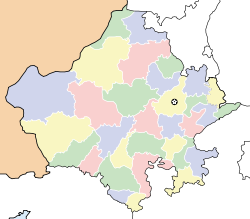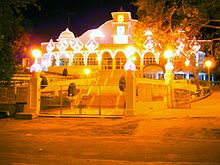- Mount Abu
-
Mount Abu Arbudaanchal Elevation 1,722 m (5,650 ft) Location Location Sirohi District, Rajasthan, India Mount Abu — city — Coordinates 24°35′33″N 72°42′30″E / 24.5925°N 72.7083°ECoordinates: 24°35′33″N 72°42′30″E / 24.5925°N 72.7083°E Country India State Rajasthan District(s) Sirohi Population
• Density
30,000 (2011[update])
• 50 /km2 (129 /sq mi)
Time zone IST (UTC+05:30) Area
• 1,164 metres (3,819 ft)
Mount Abu
 pronunciation (help·info) is the highest peak in the Aravalli Range of Rajasthan state in western India. It is located in Sirohi district. Mount Abu is 58 km from Palanpur (Gujarat). The mountain forms a distinct rocky plateau 22 km long by 9 km wide. The highest peak on the mountain is Guru Shikhar, at 1,722 metres (5,650 ft) above sea level. It is referred to as 'an oasis in the desert', as its heights are home to rivers, lakes, waterfalls and evergreen forests. The ancient name of Mount Abu is "Arbudaanchal"
pronunciation (help·info) is the highest peak in the Aravalli Range of Rajasthan state in western India. It is located in Sirohi district. Mount Abu is 58 km from Palanpur (Gujarat). The mountain forms a distinct rocky plateau 22 km long by 9 km wide. The highest peak on the mountain is Guru Shikhar, at 1,722 metres (5,650 ft) above sea level. It is referred to as 'an oasis in the desert', as its heights are home to rivers, lakes, waterfalls and evergreen forests. The ancient name of Mount Abu is "Arbudaanchal"Contents
History
The Gurjars and Arbuda Mountain
The Arbuda Mountains (Mount Abu) region is said to be original abode of the famous Gurjaras.The association of the Gurjars with the mountain is noticed in many inscriptions and epigraphs including Tilakamanjari of Dhanpala.[1] These Gurjars (Gujars or Gujjars) migrated from Arbuda mountain region and as early as sixth century A.D, they set up one or more principalities in Rajasthan and Gujarat. Almost all or a larger part of Rajasthan and Gujarat had been known as Gurjaratra (country ruled or protected by the Gurjars) or Gurjarabhumi (land of the Gurjars) for centuries prior to Mughal period.[2]
Mythology
In the Puranas, the region has been referred to as Arbudaranya, ("forest of Arbhu") and 'Abu' is a dimunitive of this ancient name. It is believed that sage Vasishtha retired to the southern spur at Mount Abu following his differences with sage Vishvamitra. There is another mythology according to which a serpant named "Arbuda" who saved the life of Nandi - Lord Shiva's bull. The incident happened on the mountain which is currently known as mount Abu and so the mountain is named "Arbudaranya" after this incident which gradually became Abu.
Tourist attractions
The town of Mount Abu, the only hill station in Rajasthan, is located at an elevation of 1,220 m (4,003 ft). It has been a popular retreat from the heat of Rajasthan and neighbouring Gujarat for centuries. The Mount Abu Wildlife Sanctuary was established in 1960 and covers 290 km² of the mountain.
Mount Abu is home to a number of Jain temples. The Dilwara Temples are a complex of temples, carved of white marble, that were built between the 11th and 13th centuries AD. The oldest of these is the Vimal Vasahi temple, built in 1021 AD by Vimal Shah and dedicated to the first of the Jain Tirthankaras.
Nakki Lake with the Maharaja Jaipur Palace and Toad Rock
The Achalgarh fort, built in the 14th century by Rana Kumbha of Mewar, stands nearby. It encloses several Jain temples, including the Achaleswar Mahadev Temple (1412) and the Kantinath Temple (1513).
Nakki Lake is another popular visitor attraction of Mount Abu. There is the Toad Rock on a hill near the lake. Raghunath Temple and Maharaja Jaipur Palace are also on hills near Nakki Lake.
The mountain is also home to several Hindu temples, including the Adhar Devi Temple, carved out of solid rock; the Shri Raghunathji Temple; and a shrine and temple to Dattatreya built atop the Guru Shikhar peak.
The Durga temple, Ambika Mata Temple lies in a cleft of rock in Jagat, just outside of Mount Abu.
Brahma Kumaris
Mount Abu is also the location of Madhuban which is the headquarters of the Brahma Kumaris World Spiritual University. The Brahma Kumaris have many large buildings here and many devotees congregate here round the year.
Climate
Summer Summer season prevails from mid of April to mid of June when average Maximum temperature remains around 36°C. Therefore it will be better if you bring light cotton clothes. These clothes are fit for the summers of Mount Abu.
Monsoon Due to its relief and geographical conditions, it rains well in Mount Abu during the monsoons. During the rainy season even the temperature falls down. Normal summer clothing will do. It is wiser to carry an umbrella in order to avoid being caught at the wrong side of monsoon.
Winter Winters are cool in Mount Abu with mercury hovering around 16°C to 22°C. Nights are really chilly and average night temperature is around 4 to 12°C. Nevertheless, there are instances when the temperature has dipped to as low as minus 2 to minus 3°C. Heavy winter clothing is preferable. You can include Long coats and Outsiders in your luggage. In daytime, light pullovers are sufficient.
Transportation
The nearest railway station is at Abu Road, in the lowlands 27 km southeast of Mount Abu town. The station is on the main Indian Railways line between Delhi,Palanpur and Ahmedabad.Its is very well connected with daily travels bus service from Ahmedabad and other big cities of Gujarat. It has regular trains for Jaipur, Jodhpur, Udaipur, Ajmer, Indore, Agra, Bhopal, Gwalior, Jabalpur, Ujjain, Delhi, Mumbai, Calcutta, Chennai, Hyderabad, Bangalore, Ahmedabad, Pune and weekly trains from Trivandrum(Kochu Veli).
Demographics
As of 2011[update] India census,[3] Mount Abu had a population of around 30000. Males constitute 58% of the population and females 42%. Mount Abu has an average literacy rate of 77%, higher than the national average of 59.5%: male literacy is 77%, and female literacy is 55%. In Mount Abu, 14% of the population is under 6 years of age.
References
- ^ Sudarśana Śarmā (2002). Tilakamañjarī of Dhanapāla: a critical and cultural study. Parimal Publications. p. 214.
- ^ Ramesh Chandra Majumdar; Achut Dattatrya Pusalker, A. K. Majumdar, Dilip Kumar Ghose, Vishvanath Govind Dighe, Bharatiya Vidya Bhavan (1977). The History and Culture of the Indian People: The classical age. Bharatiya Vidya Bhavan. p. 153.
- ^ "Census of India 2001: Data from the 2001 Census, including cities, villages and towns (Provisional)". Census Commission of India. Archived from the original on 2004-06-16. http://web.archive.org/web/20040616075334/http://www.censusindia.net/results/town.php?stad=A&state5=999. Retrieved 2008-11-01.
External links
Sirohi Cities and towns
in other districtsAjmer · Alwar · Banswara · Baran · Barmer · Bharatpur · Bhilwara · Bikaner · Bundi · Chittorgarh · Churu · Dausa · Dholpur · Dungarpur · Hanumangarh · Jaipur · Jaisalmer · Jalore · Jhalawar · Jhunjhunu · Jodhpur · Karauli · Kota · Nagaur · Pali · Pratapgarh · Rajsamand · Sawai Madhopur · Sikar · Sri Ganganagar · Tonk · Udaipur
State of Rajasthan (India) Major cities 
Divisions Districts Ajmer · Alwar · Banswara · Baran · Barmer · Bharatpur · Bhilwara · Bikaner · Bundi · Chittorgarh · Churu · Dausa · Dholpur · Dungarpur · Hanumangarh · Jaipur · Jaisalmer · Jalore · Jhalawar · Jhunjhunu · Jodhpur · Karauli · Kota · Nagaur · Pali · Pratapgarh · Rajsamand · Sawai Madhopur · Sikar · Sirohi · Sri Ganganagar · Tonk · UdaipurCategories:- Hill stations in India
- Cities and towns in Sirohi district
- Hindu holy cities
- Sacred mountains
- Hindu pilgrimage sites
- Places connected with Jainism
- Mount Abu
Wikimedia Foundation. 2010.





